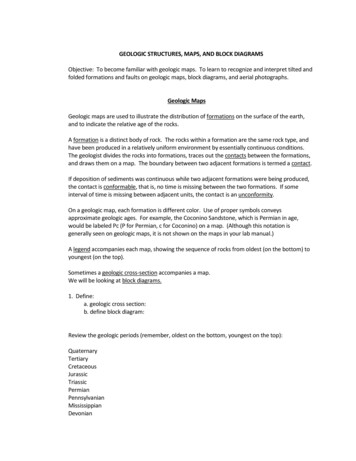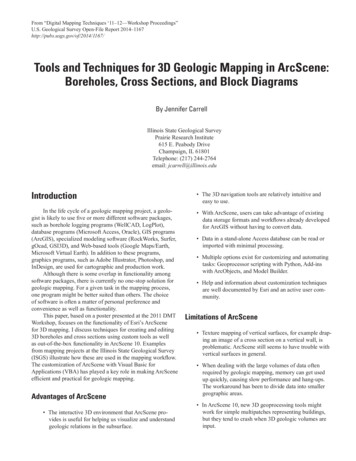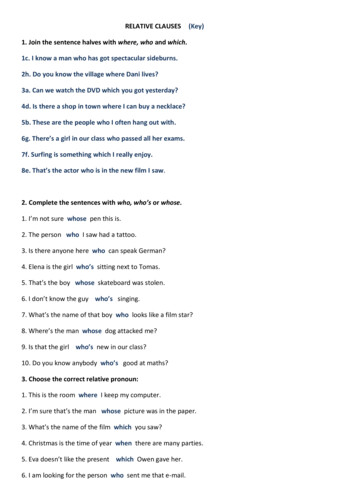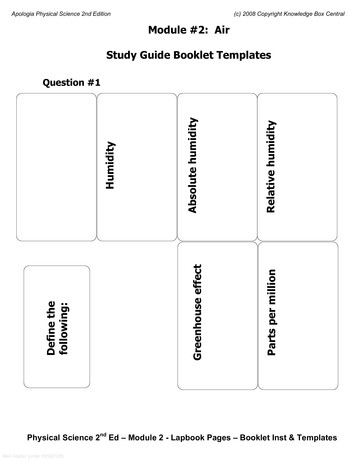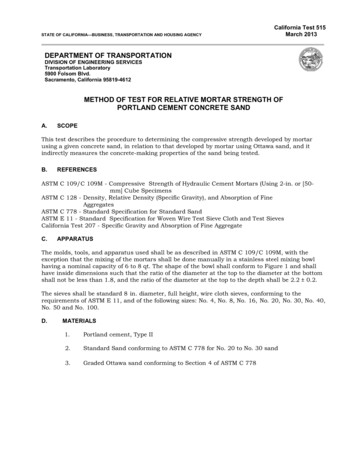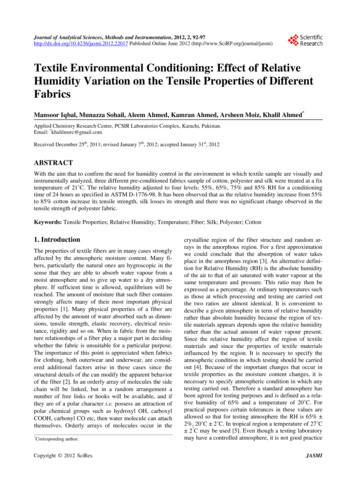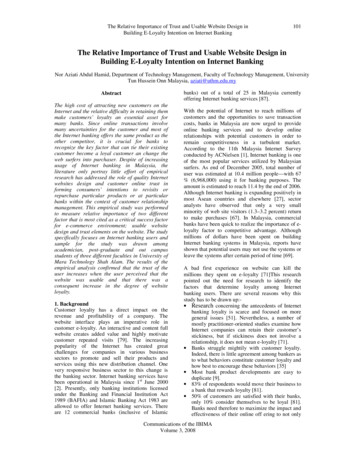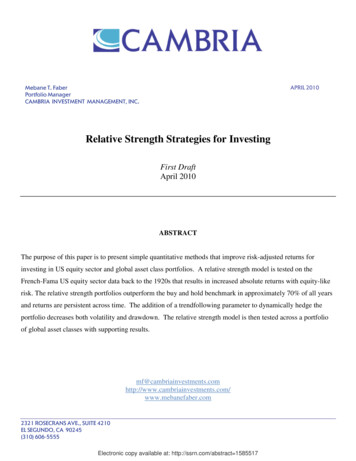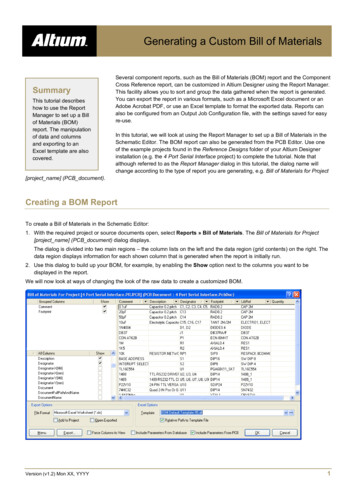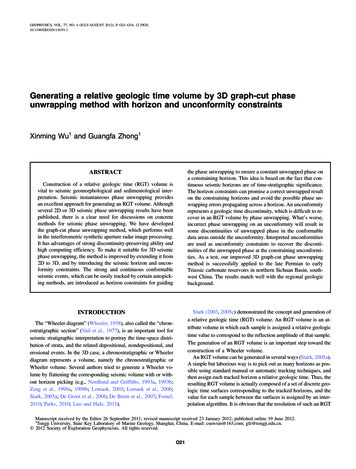
Transcription
GEOPHYSICS, VOL. 77, NO. 4 (JULY-AUGUST 2012); P. O21–O34, 12 FIGS.10.1190/GEO2011-0351.1Generating a relative geologic time volume by 3D graph-cut phaseunwrapping method with horizon and unconformity constraintsXinming Wu1 and Guangfa Zhong1ABSTRACTthe phase unwrapping to ensure a constant unwrapped phase ona constraining horizon. This idea is based on the fact that continuous seismic horizons are of time-stratigraphic significance.The horizon constraints can promise a correct unwrapped resulton the constraining horizons and avoid the possible phase unwrapping errors propagating across a horizon. An unconformityrepresents a geologic time discontinuity, which is difficult to recover in an RGT volume by phase unwrapping. What’s worse,incorrect phase unwrapping on an unconformity will result insome discontinuities of unwrapped phase in the conformabledata areas outside the unconformity. Interpreted unconformitiesare used as unconformity constraints to recover the discontinuities of the unwrapped phase at the constraining unconformities. As a test, our improved 3D graph-cut phase unwrappingmethod is successfully applied to the late Permian to earlyTriassic carbonate reservoirs in northern Sichuan Basin, southwest China. The results match well with the regional geologicbackground.Construction of a relative geologic time (RGT) volume isvital to seismic geomorphological and sedimentological interpretation. Seismic instantaneous phase unwrapping providesan excellent approach for generating an RGT volume. Althoughseveral 2D or 3D seismic phase unwrapping results have beenpublished, there is a clear need for discussions on concretemethods for seismic phase unwrapping. We have developedthe graph-cut phase unwrapping method, which performs wellin the interferometric synthetic aperture radar image processing.It has advantages of strong discontinuity-preserving ability andhigh computing efficiency. To make it suitable for 3D seismicphase unwrapping, the method is improved by extending it from2D to 3D, and by introducing the seismic horizon and unconformity constraints. The strong and continuous conformableseismic events, which can be easily tracked by certain autopicking methods, are introduced as horizon constraints for guidingINTRODUCTIONStark (2003, 2005c) demonstrated the concept and generation ofa relative geologic time (RGT) volume. An RGT volume is an attribute volume in which each sample is assigned a relative geologictime value to correspond to the reflection amplitude of that sample.The generation of an RGT volume is an important step toward theconstruction of a Wheeler volume.An RGT volume can be generated in several ways (Stark, 2005a).A simple but laborious way is to pick out as many horizons as possible using standard manual or automatic tracking techniques, andthen assign each tracked horizon a relative geologic time. Thus, theresulting RGT volume is actually composed of a set of discrete geologic time surfaces corresponding to the tracked horizons, and thevalue for each sample between the surfaces is assigned by an interpolation algorithm. It is obvious that the resolution of such an RGTThe “Wheeler diagram” (Wheeler, 1958), also called the “chronostratigraphic section” (Vail et al., 1977), is an important tool forseismic stratigraphic interpretation to portray the time-space distribution of strata, and the related depositional, nondepositional, anderosional events. In the 3D case, a chronostratigraphic or Wheelerdiagram represents a volume, namely the chronostratigraphic orWheeler volume. Several authors tried to generate a Wheeler volume by flattening the corresponding seismic volume with or without horizon picking (e.g., Nordlund and Griffiths, 1993a, 1993b;Zeng et al., 1998a, 1998b; Lomask, 2003; Lomask et al., 2006;Stark, 2005a; De Groot et al., 2006; De Bruin et al., 2007; Fomel,2010; Parks, 2010; Luo and Hale, 2011).Manuscript received by the Editor 26 September 2011; revised manuscript received 23 January 2012; published online 19 June 2012.1Tongji University, State Key Laboratory of Marine Geology, Shanghai, China. E-mail: csuwxm@163.com; gfz@tongji.edu.cn. 2012 Society of Exploration Geophysicists. All rights reserved.O21
Wu and ZhongO22volume thus depends on the accuracy of horizon tracking and thenumber of horizons tracked. The main problem of the method is thatvast information between the horizons goes ignored, which reducesthe resolution of the resultant RGT volume.Stark (2003, 2004a, 2004b, 2005a, 2005b, 2005c, 2006) illustrates an excellent idea to generate an RGT volume through unwrapping seismic instantaneous phase. It is based on the fact that thephase attribute in seismic data carries time information in the process of wave propagation, that is, the absolute or true phase of seismic data always increases with traveltime; therefore, the absolutephase estimated by unwrapping the seismic instantaneous phaseshould be equivalent to the relative geologic time under theassumption that an event or a horizon with the same instantaneousphase corresponds to a geologicly isochronal surface (Stark,2003, 2005c).Phase unwrapping is a common technique in certain fields of image processing, including the interferometric synthetic aperture radar imaging (InSAR), magnetic resonance imaging (MRI), and soon. Some phase unwrapping methods have been developed (e.g.,Goldstein et al., 1988; Ghiglia and Pritt, 1998), but most of themare 2D, which is not suitable for phase unwrapping of 3D seismicdata. In addition, due to the particularity of seismic phase unwrapping, the methods are expected to undergo certain modifications sothat they can produce better results in seismic phase unwrapping. Inparticular, some geologic and geophysical conditions should be metin seismic instantaneous phase unwrapping. For example, the estimated unwrapped phase should always increase with traveltime invertical seismic sections (Stark, 2003, 2005a), and an abrupt jumpof the unwrapped phase should be expected at an unconformity,which is similar to a surface fault in InSAR data.Shatilo (1992) discusses the methods of 1D seismic instantaneous phase unwrapping. Several authors report their 2D or 3D results of seismic instantaneous phase unwrapping (Stark, 2003,2004b, 2005c; Imhof and Tech, 2004; De Matos et al., 2009),but no detailed discussion on the phase unwrapping method or algorithm was published. In this paper, the graph-cut phase unwrapping method, presented by Valadão and Bioucas-Dias (2009) inInSAR data processing, is introduced into seismic instantaneousphase unwrapping. Some improvements to the method are developed, including the extension of the method from 2D to 3D, andthe introduction of geologic horizon and unconformity constraintsinto the process of phase unwrapping. As a test, our improved method is applied to the late Permian to early Triassic carbonate reservoirs in the northern Sichuan Basin, southwest China. The resultsmatch well with the regional geologic background, suggesting therobustness of the method.METHODBrief review of current phase unwrapping methodsIn general, the phase extracted from a real signal by a certainmathematical operation is referred to as a wrapped phase, whichlies between π and þπ in radians. In reflection seismology, theinstantaneous phase, extracted from seismic data through theHilbert transform (Taner et al., 1979) or wavelet transform (e.g.,Gao et al., 1999), belongs to wrapped phase φi . It is related to absolute phase ϕi , the true phase of an actual signal, byφi ¼ Wðϕi Þ ¼ ϕi 2πki ;(1)where ki is an integer, and W is called the wrapped operator thatwraps all values of its argument into the range ð π; πÞ by adding orsubtracting an integral multiple of 2π radians from its argument(Ghiglia and Pritt, 1998). Phase unwrapping is the operation tosolve for the absolute phase ϕi from the wrapped phase φi . Definethe absolute phase difference Δϕi and the wrapped phase differenceΔφi as Δϕi ¼ ϕi ϕi 1 and Δφi ¼ φi φi 1 , respectively. If theabsolute phase satisfies the Itoh condition (Itoh, 1982),jΔϕi j π;(2)Δϕi ¼ WðΔφi Þ:(3)thenThis suggests that phase unwrapping is, theoretically, a simpleline integration problem over the wrapped phase data, assumingthe absolute phase ϕi satisfies the Itoh condition (equation 2).The absolute phase at the arbitrary nth point of the integrationor phase unwrapping path can be calculated, starting at point i0 , byϕn ¼ φi0 þnXΔφi :(4)i¼1Unfortunately, the Itoh condition is not always satisfied, due tothe existence of noise, objective discontinuities (e.g., unconformities or faults in seismic data), and possible undersampling (i.e.,violations of Shannon’s law) in real wrapped phase data. Therefore,instead of a simple line integration problem, phase unwrapping isusually a complicated ill-posed problem (Valadão and BioucasDias, 2009).Numerous phase unwrapping methods have been developed,which can be roughly grouped into four types: the path-followingmethods, the minimum-norm methods, the Bayesian methods, andthe parametric-model-based methods (Dias and Leitão, 2002). Inthe path-following methods, phase unwrapping is achieved by integrating over the whole wrapped phase data along a given integration path, on which all the corresponding absolute phase data areassumed to meet the Itoh condition. Knowing how to find a correctintegration path is crucial to the methods. Two main methods havebeen presented, which are the branch-cut method and qualityguided method, respectively. The branch-cut method (Goldsteinet al., 1988) tries to find the samples that violate the Itoh conditionand then connect them by lines, the so-called “branch cuts,” whichwill not be passed by the phase unwrapping path. Although it runsfast and saves memory, the branch-cut method uses only the information from local phase points in connecting the branch cuts. Oncethe branch cuts are connected incorrectly, errors will propagatealong the phase unwrapping path, which means the phase unwrapping result is not a globally optimized solution. Moreover, due tothe influences of possible unconformities, faults, and noise, largeamounts of samples violating the Itoh condition may exist in realseismic instantaneous phase data, which may make the correct placing of branch cuts in seismic phase unwrapping difficult. The quality-guided method locates the points that violate the Itoh conditionby using a quality map, which is generally extracted from a correlation map or a phase derivative variance map of the wrapped phase
Generating RGT volume by phase unwrappingdata. In such a quality map, the points that violate the Itoh conditiontend to have low values (Ghiglia and Pritt, 1998). Therefore, an integration path is suggested to follow the points with high values inthe quality map, and avoid those with low values. If a reliablequality map is available, the method usually performs better thanthe branch-cut method (Ghiglia and Pritt, 1998).Minimum-norm phase unwrapping methods are based on the assumption that most absolute phase values satisfy the Itoh condition,and thus the absolute phase difference is almost always equal to thewrapped phase difference (equation 3). The methods are used tofind an absolute phase solution when the Lp norm of the differencebetween the absolute phase difference and the wrapped phase difference is minimized. Therefore, the minimum-norm methods adopta global optimization strategy to solve for the unwrapped phase(Valadão, 2006). The main problem of these methods is that theyessentially neglect the absolute phase samples that do not meet theItoh condition, including those that represent the true discontinuitiesof the interested geologic objects (for example, the stratal unconformities or faults in the seismic data). When p ¼ 2, phase unwrapping turns into a classical least-squares problem, from which aunique global optimum solution can be obtained by the fast Fouriertransform technique. In this case, however, the true discontinuitiesof the absolute phase will be smoothed without the constraints froma quality map. The representative methods for the case p ¼ 1 include Flynn’s (1997) minimum weighted discontinuity algorithmand Costantini’s (1998) network programming method. Superiorto the least-squares methods when p ¼ 2, both methods have gooddiscontinuity-preserving properties. When 0 p 1, the discontinuity-preserving ability of the algorithms is further enhanced, butthe algorithms will become extraordinarily complex and they turninto NP-hard problems (Bioucas-Dias and Valadão, 2007).The Bayesian methods (e.g., Dias and Leitão, 2002; BioucasDias and Valadão, 2005, 2007; Valadão, 2006; Valadão and Bioucas-Dias, 2009) treat phase unwrapping as a problem of “maximuma posteriori” (MAP) estimation. According to the Bayesian theorem, the MAP estimation can be transformed to a Lp norm minimization of an energy function, by introducing the a prioriprobability and the likelihood function. The a priori probabilitycan be acquired by using a first-order Gauss-Markov random fieldto model the absolute phase, and the likelihood function can be constructed based on a data-observation mechanism model (BioucasDias and Valadão, 2007; Dias and Leitão, 2002). The methods havegood denoising ability because noise is considered in the construction of the observation mechanism model, which makes the methods superior to the path following and minimum-norm methodsmentioned above. Bioucas-Dias and Valadão (2005, 2007), Valadão(2006), and Valadão and Bioucas-Dias (2009) applied the graph-cutmethod to solve the Lp norm minimization problem. The graph-cutmethod is based on the max-flow/min-cut algorithms (Greig et al.,1989; Veksler, 1999; Boykov et al., 2001; Boykov and Kolmogorov,2004; Kolmogorov and Zabih, 2004); and, with high flexibility, it issuitable for solving the Lp norm minimization for 0 p. The method is characterized by good denoising performance, good discontinuity-preserving ability (when 0 p 1), and high efficiency ofcomputation.For the methods based on parametric models (Friedlander andFrancos, 1996; Liang, 1996), absolute phase is solved by fittingthe estimated absolute phase to a given parametric model. If a reasonable parametric model is available, a globally optimal solutionO23of phase unwrapping result will be obtained. However, a parametricmodel matching well with the whole absolute phase data is usuallydifficult to find, which limits the applications of the methods (Diasand Leitão, 2002).Method adopted in this paperOn the basis of a comparative analysis of the phase unwrappingmethods mentioned above, the graph-cut phase unwrapping method, presented by Valadão and Bioucas-Dias (2009), is introducedinto the seismic instantaneous phase unwrapping to generate anRGT Volume. To make the method suitable for seismic phase unwrapping, some improvements have been developed, including theextension of the original 2D method into a 3D one, and the introduction of the seismic horizon and unconformity constraints into theprocess of phase unwrapping. These improvements greatly increasethe accuracy and reliability of seismic phase unwrapping results.As one type of Bayesian method, the graph-cut method is built ona statistical model in which the absolute phase ϕi and the wrappedphase φi are considered as random variables; and the sets of thephases are treated as random fields, which are denoted asΦ ¼ fϕi ; i Vg and Ψ ¼ fφi ; i Vg, respectively (V representsthe set of all the data samples of the corresponding data set). Thenthe phase unwrapping from Ψ to Φ can be regarded as an estimationproblem using the MAP estimator: ¼ arg maxΦ pðΦjΨÞ arg maxΦ pðΨjΦÞ pðΦÞ;Φ(5)where pðΨjΦÞ is the likelihood function; pðΦjΨÞ and pðΦÞ are theposterior and a priori probabilities, respectively.Observation model and likelihood functionDefine a seismic data set s ¼ fsi ; i Vg, which is considered asa random field. A seismic observation model can be depicted assi ¼ ai cos ϕi þ ni ;(6)where ai and ϕi are instantaneous amplitude and absolute phaseof the theoretical seismic data without noise, respectively; ni represents noise. By applying the Hilbert transform to equation 6, thecorresponding complex seismic data Si are obtained, which canbe expressed asSi ¼ Ai e jϕi þ N i ¼ jSi je jðϕi þϕNi Þ ¼ jSi je jðϕSi Þ ;(7)where N i is the complex noise corresponding to ni ; ϕNi is the phasefrom the complex noise N i , and ϕSi is the absolute phase of thecomplex seismic data (Si ) with noise; j is the imaginary unit.Assume the noise N i meets N i ð0; σ 2 Þ and is independent tothe absolute phase ϕi , then the likelihood function of Si can be written by (Valadão and Bioucas-Dias, 2009)1 pðSi jϕi Þ ¼ 2 eπσ!jSi Ai e jϕi j2σ2":(8)This can be simplified aspðSi jϕi Þ ceλi cosðϕi φi Þ ;(9)
Wu and ZhongO24ijwhere c is a constant; λi ¼ 2Aσi jS2 ; and φi ¼ argðSi Þ ¼ WðϕSi Þ(φi ½ π; þπ&) is the wrapped instantaneous phase computed fromthe observed seismic data with noise. Therefore, the likelihoodfunction of φi can be written bypðφi jϕi Þ ceλi cosðϕi φi Þ:(10)Assuming the components of Ψ are conditionally independent,thenpðΨjΦÞ ¼ Πi v pðφi jϕi Þ cePλi v icosðϕi φi Þ:(11) ¼ arg minΦ EðΦjΨÞ:ΦConsider the relationship between the absolute and wrappedphase dataΦ ¼ Ψ þ 2Kπ; K Z;# X pðΦÞ exp μ VðΔϕi;j ÞW i;j ; ¼ arg minK EðKjΨÞ;KpVðΔϕij Þ ¼ jΔϕij j :EðKjΨÞ ¼(12)Based on the Bayesian theorem, the posterior probabilitypðΦjΨÞ can be deduced from equations 11 to 13#pðΦjΨÞ exp μXi;j εVðΔϕi;j ÞW i;j þXi V λi cosðϕi ϕi Þ :(14)Take a negative logarithm on both sides of above equation, anddefine its right side as an energy function, notated as EðΦjΨÞ:Xi Vi Vð λi Þ þ μXi;j εjΔϕi;j jp W i;j :(19)EðKjΨÞ Xi;j εjΔϕi;j jp W i;j :(20)In a 2D situation, EðKjΨÞ can be decomposed asEðKjΨÞ Xi;j εjΔϕhi;j jp W hi;j þ jΔϕvi;j jp W vi;j ;(21)where W hi;j and W vi;j are weights representing horizontal and verticalquality information of the phase data, respectively; Δϕhi;j andΔϕvi;j are given by Δϕhi;j ¼ 2πðki;jþ1 ki;j Þ þ φi;jþ1 φi;j, andΔϕvi;j ¼ 2πðkiþ1;j ki;j Þ þ φiþ1;j φi;j . For the sake of notationalsimplicity, Ehi;j and Evi;j are defined byEhi;j ðki;jþ1; ki;j Þ ¼ W hi;j j2πðki;jþ1 ki;j Þ þ φi;jþ1 φi;j jp ;(22)andMAP estimationEðΦjΨÞ ¼XBecause λi is independent of ki (ki K),(13)In equation 13, Δϕij ¼ ϕi ϕj , and the exponent p ½0; 2& is akey parameter for the graph-cut phase unwrapping method. When0 p 1, the method is excellent at preserving discontinuity(Bioucas-Dias and Valadão, 2007; Valadão and Bioucas-Dias,2009); but when p 1, the discontinuity-preserving ability ofthe method weakens gradually. Therefore, the method is most suitable for the case of 0 p 1. In this paper, p is defined between 0and 1 (0 p 1). Bioucas-Dias and Valadão (2007) and Valadãoand Bioucas-Dias (2009) present some specific definitions of thepotential function.(18)where EðKjΨÞ can be expressed asi;j εwhere μ is a constant (μ 0), ε is the set of edges connecting twohorizontal or vertical neighboring points (Valadão and BioucasDias, 2009); i and j represent the two neighboring points;W ij ½0; 1& is a nonnegative weight, representing the quality ofthe instantaneous phase data; VðΔϕij Þ is the potential function,which is a real function defined as follows:(17)where K is an integer data set with the same size and dimension asthe wrapped phase data set (Ψ). Then phase unwrapping turns into aprocess to find the integer data set K by minimizing the energyfunctionA priori probabilityConsidering the absolute phase data set Φ as a first-orderGauss-Markov random field, the a priori probability can be givenby (Dias and Leitão, 2002)(16) λi cosðϕi φi Þ þ μXi;j εjΔϕi;j jp W i;j : (15)Then, the MAP estimation in equation 5 turns into a problem ofminimizing the energy function EðΦjΨÞ in equation 15:Evij ðkiþ1j; kij Þ ¼ W vij j2πðkiþ1j kij Þ þ φiþ1j φij jp : (23)Therefore, equation 18 can be written as ¼ arg minK EðKjΨÞ arg m
The “Wheeler diagram” (Wheeler, 1958), also called the “chron-ostratigraphic section” (Vail et al., 1977), is an important tool for seismic stratigraphic interpretation to portray the time-space distri-bution of strata, and the related depositional, nondeposit
